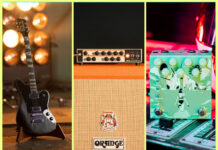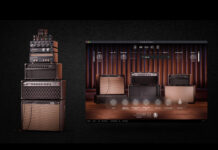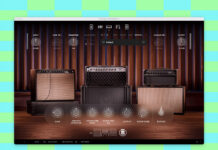
Solar Guitars Chug Pedal review: It does the thing
Reviewing the Chug Pedal, a new high-gain preamp pedal from Ola Englund’s Solar Guitars, is a bit like reviewing a hammer. There might be some nuance in the carve of the handle and the weight of the head: but hit a nail with it, and it’s either going to do the thing it’s designed to do, or it’s not. To torture this metaphor a little further, there’s also no point in seeing how well it turns a screw, or makes an omelette.
READ MORE The Big Review: Two Notes ReVolt Guitar – the ultimate multi-channel amp in a box?
The Chug Pedal is a true preamp, designed to replace the front end of an amplifier. It doesn’t have any cabinet sounds of its own, so it’s happiest plugged into either a power amp, a dedicated cab-sim unit like a Mooer Radar, or an audio interface with cabinet simulation running in software. The controls on the pedal itself consist of six knobs, the outer pair of which are concentric, making it just a hair wider than a standard Boss pedal. The top row is a three-band EQ, plus controls for depth and presence. The bottom row has an output level, a threshold for the onboard noise gate, and three gain controls: one for overall gain and a concentric control for low- and high-frequency gain. With specs out the way, let’s answer that single burning question, the one Ola Englund has centred an entire YouTube show around:
Will. It. Chug?
In use
In short: yes.
In long:
We gave it a go both into the valve power amp section of a tube head, and into an audio interface with a software IR. Starting into the real amp, we set everything to noon, and, well, it chugs. It does the sound. The sound that makes you want to play nothing but palm-muted gallops all day. The knobs are really just there to fine-tune this one thing, which, again, isn’t a bad thing – hammer, nail. The drive character is indeed high gain, but it’s not fuzzy in its saturation: there’s enough headroom to let the initial attack poke through, meaning that even when galloping along at speed your playing isn’t going to get lost in a wall of distortion.
Plugging the Chug Pedal into an audio interface, we load up a free IR loader plugin in a DAW – and are immediately impressed. We check that we couldn’t get the same results with another overdrive pedal, and nope, that’s a one-way ticket to fizz city. The bite to the high-end of the Chug Pedal is a little more pronounced when it’s going direct, but that’s easy to dial out by rolling off presence a touch.
It handles every single guitar we throw at it just fine, even if it does this by making all of them sound exactly the same. Transparent, this is not: the frequency response has quite a dramatic midrange profile, grinding down a guitar’s tonal idiosyncrasies into the same shape every time. Even a Jazzmaster’s single-coils produce heavy chugs through it, without any noise thanks to the on-board gate.
You can only adjust the threshold level of the noise gate, whereas the decay time has been factory set (from what we can tell) to be very quick. It clamps down hard as soon as you stop playing. We never have any issues with it: once set at the right level, it never cuts us off unexpectedly, and the fast decay is one more thing that adds to the chugginess. The bypass LED also turns green when it’s letting your signal through, and red when the gate is closed, handy for quickly setting levels before you turn the volume up.
The rest of the controls behave as expected: bass adds bass, treble adds treble, gain is gain, volume is volume and so on. We can’t help but feel, however, that the midrange control is a bit lacklustre: no matter where it’s set, there’s always a spike in the upper mids. On a preamp aiming to always sound like a Tube Screamer in front of a high-gain head, this isn’t too surprising. But a parametric midrange control, letting you place the mids-bump in a location of your choosing, would really open up the pedal’s voicing options. While the faux-concentric midrange knob visually matches its actually concentric siblings, it serves as a bittersweet reminder of this missing functionality.
With the chugging options exhausted, then, we come back to the proverbial hammer’s proverbial omelette: the clean tone. Would you be shocked to learn that it’s the pedal’s biggest downfall? No matter how hard we try, there’s only one setting on the pedal that gets us anything even remotely clean, and that’s ‘off’. We can’t really deduct many points for that: in an alternate universe, the Chug Pedal has a separate clean channel and is twice as wide to accommodate a feature that basically all of its users are going to ignore.
The only other downside is that, in contrast to some ‘amp pedals’ on the market, it’s not a one-stop shop for a direct sound, or for driving a speaker: it has to be paired with either an IR loader or a real power amp and cab. But the Chug Pedal makes up for this with a different kind of flexibility: costing half as much as both the Walrus ACS1 and the Strymon Iridium, and packed into a compact enclosure, it leaves ample room in your budget and on your pedalboard. Whack something like a Mooer Radar next to it for instant direct sounds, or pair it with an EHX Howitzer or an Orange Pedal Baby to move some real air with a cab. Or, handle the IR simulation in software for literally zero dollars (bar the cost of a laptop and an interface). And as a home-recording and/or practice tool for metal of all stripes, we can’t really fault it.
Key Features
PRICE $199
DESCRIPTION Preamp pedal, made in China
CONTROLS Output, gate threshold, overall gain, low- and high-frequency gain, three-band EQ, depth and presence
FEATURES True bypass, standard 9V power supply (100mA minimum), colour-changing LED indicating noise-gate activity
DIMENSIONS 120mm x 70mm x 50mm
CONTACT solar-guitars.com
Like this? Try These:
Strymon Iridium (£379)
Horizon Devices Apex Preamp Pedal (£319)
Electronic Audio Experiments Model feT ($249)
The post Solar Guitars Chug Pedal review: It does the thing appeared first on Guitar.com | All Things Guitar.
Source: www.guitar-bass.net













